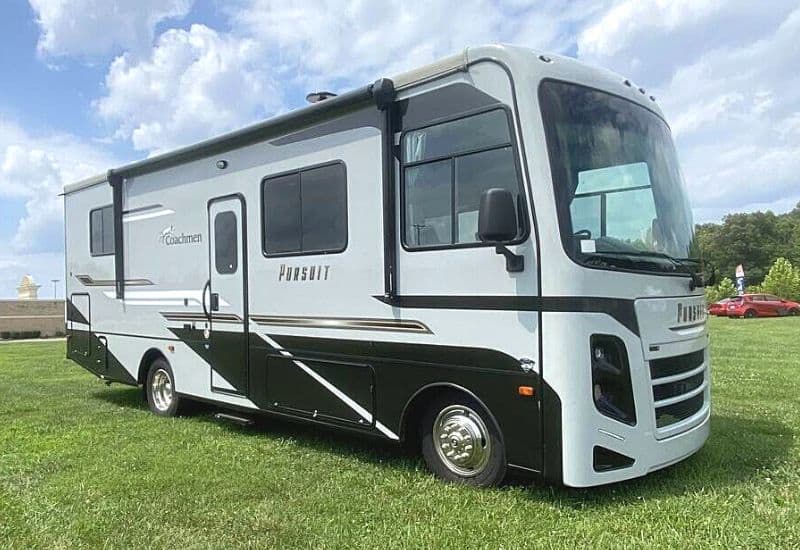If you dream of hitting the open road in a lavish home-on-wheels, there is no better option than the Class A motorhome, as these flagship RVs offer five-star luxury, spacious layouts, and next-level comfort.
If you’re new to RVs though, you might be wondering what a Class A motorhome is.
In the simplest terms, a Class A motorhome is a large driveable, bus-style recreational vehicle offering spacious and luxurious accommodations, ideal for extended travel or full-time living.
There’s a lot more to know about Class A RVs though, than just their basic definition.
Including what their defining characteristics are, what their advantages and disadvantages are, and how they compare to other types of motorhomes.
So, if you’re new to RVing or thinking about buying one, make sure to keep reading.
Because, in the rest of this blog post, we’re doing a deep dive into the Class A motorhome.
Distinguishing Features of Class A Motorhomes
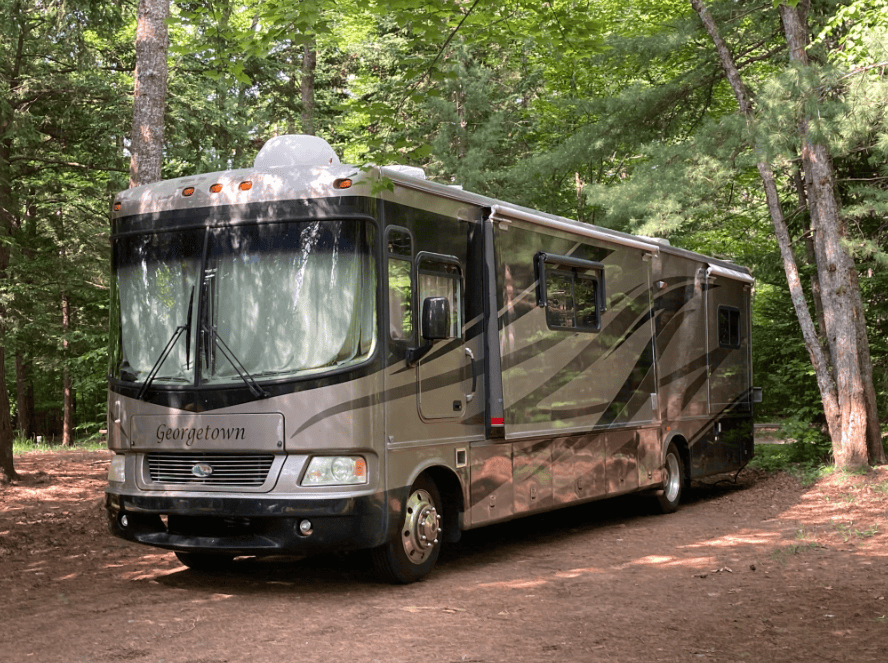
When you spot a Class A RV on the road, there’s no mistaking it.
Resembling commercial buses in size and style, these luxury liners have an unforgettable and imposing profile and overall shape, from their distinct vertical front to their tall height and substantial length.
These distinguishing looks aren’t just for show though, as they also allow these flagship motorhomes to offer class-leading space, features, and amenities.
Constructed on a Bus Chassis
Class A RVs build their foundations directly on a bus-style chassis in contrast with other motorhome classes.
Popular chassis options for Class A RVs include Ford’s F53, Freightliner, Spartan, PowerGlide, DynoMax, and Prevost.
These heavy-duty chassis provide unmatched strength and reliability, essential for supporting the large size and weight of Class A motorhomes, which can top out at over 30,000 pounds!
Their robust construction also allows for greater customization and luxury features, accommodating expansive living spaces, high-end appliances, and sophisticated technology.
Integrated Driver Cockpit
Unlike Class B and Class C motorhomes, which have separate driving and living spaces, Class A RVs offer integrated driver cockpits that seamlessly blend with the living area, providing an open and expansive feel throughout the vehicle.
This design allows for easy interaction between the driver and passengers, creating a more social and inclusive environment even while on the move.
Plus, it also extends the useable living space, as the driver and co-pilot seats can usually be swiveled around when parked for additional seating.
Residential Level Amenities
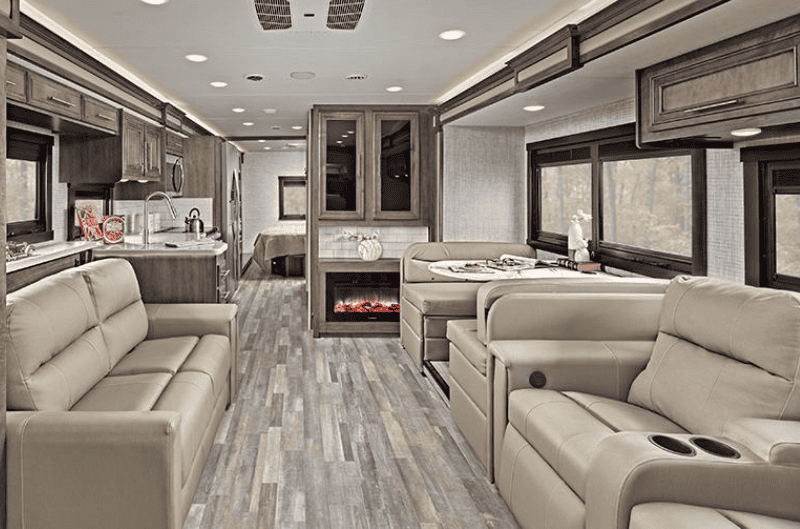
Step inside almost any Class A motorhome and you’ll be met with swanky features more common in custom homes than vehicles.
Including solid surface countertops, tile floors, leather sofas, and stainless steel appliances.
Other upscale touches incorporate cutting-edge technology like accent lighting, heated tile flooring, LED TVs, wireless charging stations, and smartphone app integration to control everything, including lighting, awnings, and more.
Dedicated Owner’s Suite & High Sleeping Capacities
Well-appointed bedrooms and high sleeping capacities are a hallmark of Class A floorplans.
Most contain a spacious rear owner’s suite with either a queen or king bed.
As well as numerous other sleeping accommodations spread throughout the coach, including convertible dinette booths, jack-knife sofas, and drop-down overhead bunks.
Which when combined allows 6 to 10 people to comfortably sleep inside the RV, depending on the make and model.
Fully Equipped Bathrooms
Another distinguishing characteristic typical of Class A RVs is their spacious fully equipped bathrooms.
Unlike smaller motorhome bathrooms, they offer full-featured three-piece dry baths similar to what you would find in a residential home.
With walk-in showers (some with built-in seating), porcelain toilets, and linen closets.
In fact, large luxury models often have multiple bathrooms and setups similar to what you might find in a luxury hotel.
With full glass showers, double vanities, extensive tile work, heated floors and towel racks, and premium finishes throughout.
Spacious Well-Equipped Kitchens
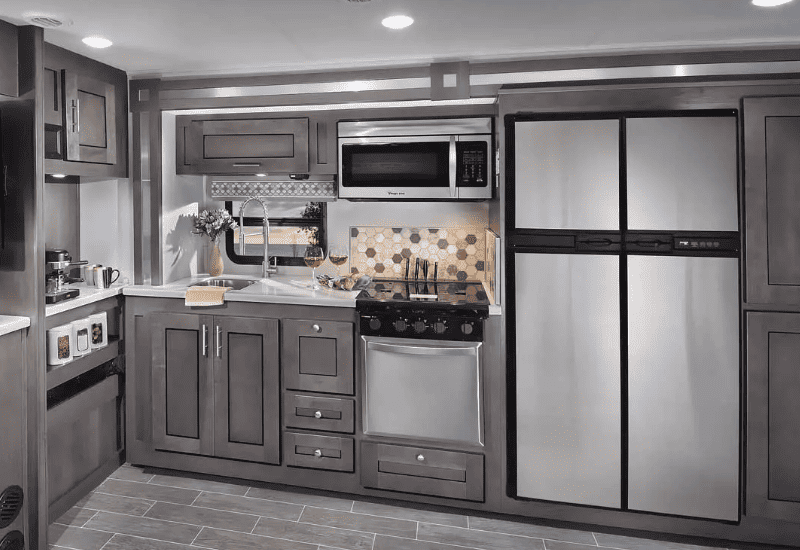
While smaller motorhomes like Class B and C RVs typically offer limited kitchens, Class A motorhomes offer full-featured kitchens with all the appliances you’d find at home.
Including double-door residential refrigerators, convection microwave ovens, multi-burner cooktops, and ovens.
Plus, they also typically offer ample counter space, high-rise faucets, extra deep sinks, and plenty of upper and lower cabinets for storage.
Higher-end models can even offer solid surface countertops, tile backsplashes, coffee bars, and even dishwashers.
Comfortable Living & Entertainment Spaces
Thanks to their large size and multiple slide-outs, Class A motorhomes typically offer comfortable open living spaces.
Featuring panoramic windows and lots of comfortable seating, including plush couches, power recliners, and roomy dinette booths.
In addition, these mobile living rooms usually offer other residential touches like fireplaces, large entertainment centers, and a mix of materials, including tile, wood, and leather, giving the coach a homey feel.
Abundant Exterior & Interior Storage
Class A motorhomes offer the greatest amount of both exterior and interior storage space, thanks to ample interior cabinetry and basement storage that runs the length of the vehicle.
Class A RVs typically offer extensive interior cabinetry that lines the walls, offering an array of compartments, drawers, and closets tailored for everything from kitchen utensils to clothing, and supplies.
Beneath the living quarters, basement storage compartments that run the length of the vehicle provide a substantial area for larger items.
This basement area is often accessible from both sides of the RV, making it incredibly convenient for loading and unloading gear, tools, and outdoor recreational equipment.
Outdoor Living Spaces
Class A motorhomes also excel at creating comfortable and inviting outdoor living spaces.
Allowing you to extend your living space beyond the motorhome’s interior.
Often equipped with large power awnings with LED lighting, these push-button awnings provide shade during the heat of the day and a relaxing place to hang out during the evening.
In addition, most Class A RVs also offer outdoor entertainment systems with exterior speakers and TVs, which allow you to catch the big game or enjoy movie night under the stars.
Some Class A RVs even offer outdoor kitchens, which often include a mini-fridge, a sink, pull-out counters, storage drawers, and sometimes even a gas range or electric burner for cooking.
Benefits of Owning a Class A RV
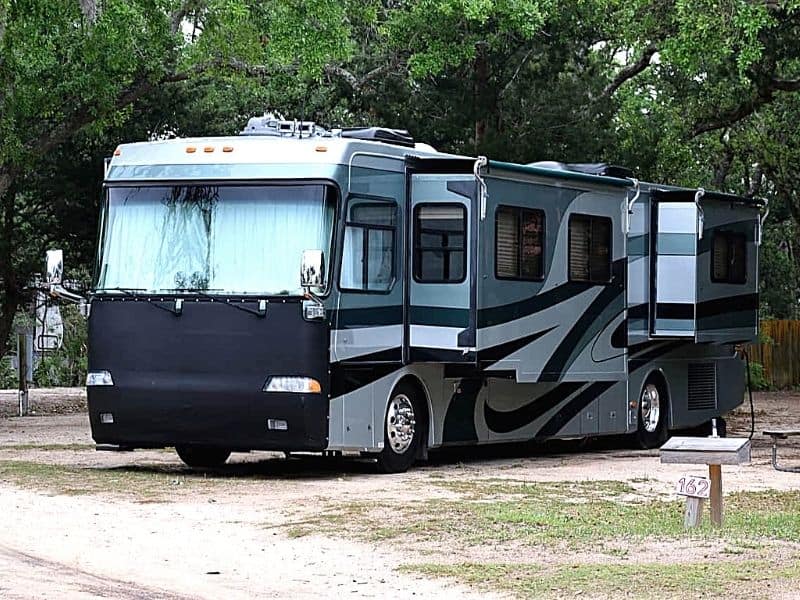
Beyond their next-level luxuries, Class A motorhomes offer unique advantages that enhance any RV lifestyle including:
- Spacious Living Quarters – Offers expansive open interiors with dedicated spaces that provide a home-like feel.
- High Sleeping Capacities – Can comfortably accommodate larger families or groups (typically 6 to 10 people at a time) thanks to multiple dedicated and convertible sleeping areas.
- Well-Suited to Full-Time Living – One of the best options for extended or full-time RV living, thanks to their large size, feature-rich interiors, home-like amenities, and ample storage.
- Large Towing Capacities – Offers the highest towing capacities available for a motorhome, with standard models offering between 5,000 and 10,000 pounds, and luxury models offering 20,000 pounds. Allowing you to trailer cars, boats, or even horse trailers.
- Excellent Self-Sufficiency – Excels at boondocking, due to numerous off-grid-friendly features like large holding tanks, onboard generators, propane appliances, roof-top solar panels, and built-in inverters.
- Luxurious Ride – Offers one of the smoothest rides available in a motorhome, thanks to their heavy-duty chassis, upgraded suspension, responsive steering, larger tires, and tag axles on large models.
Downsides of Class A Motorhomes
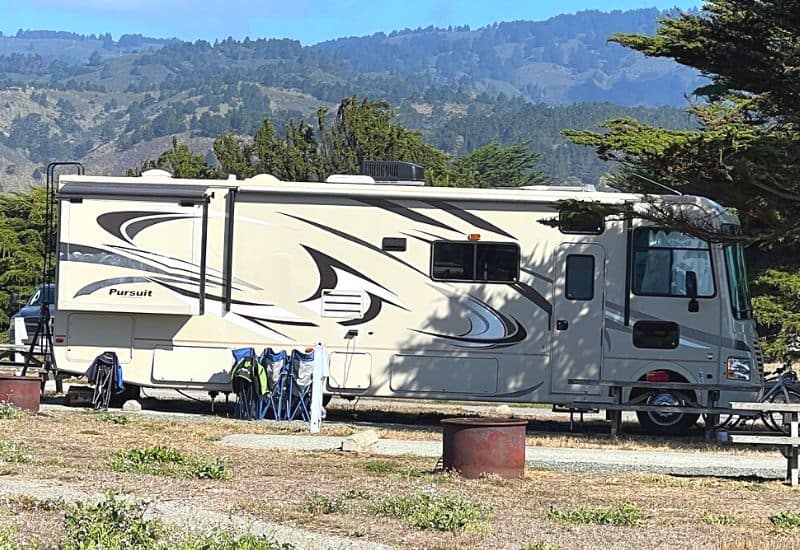
It’s not all good news for Class A motorhomes though, as there are some drawbacks, starting with their shockingly high price tag.
And that’s not even accounting for ongoing ownership costs.
Filling the tank, poor mileage, finding parking, and maneuvering a bus-sized vehicle round out the other trade-offs.
- Expensive Purchase Price – New Class A motorhomes start at around $100,000 and quickly go up from there, with some of the most expensive models like the Emerald Prevost and the Newell Coach costing more than 1 million.
- Poor Gas Mileage – Have shockingly bad fuel efficiency, as most get somewhere between 6 and 10 miles per gallon. Making fill-ups frequent and costly, due to their 100-gallon fuel tanks.
- Maintenance & Ownership Costs – Price and fuel aren’t the only costs associated with owning a large motorhome, as everything is more expensive, including insurance premiums, registration renewals, loan payments, repairs, and maintenance.
- Limited Access & Parking Restrictions – Due to the longer length, taller height, and overall larger size of Class A motorhomes, it can limit where you can drive, park, and camp. Low clearances, length limits, bridge restrictions, and other size barriers are common issues with owning and operating a larger motorhome. Which can prevent Class A access in certain areas, parks, campgrounds, and campsites.
- Reduced Handling & Maneuverability – Have reduced handling and maneuverability, due to their larger size and heavier weight. Because of this, they require a different style of driving. One that accounts for slower acceleration, wider turns, and increased stopping distance as well as rear overhang and off-tracking.
How Class A Motorhomes Compare to Class B and C RVs
With their unrivaled size and luxury, you might wonder why anyone wouldn’t opt for a Class A.
However, these large bus-style motorhomes are not always the best fit for everyone.
As Class B and C RVs can make sense for many RVers, thanks to their smaller size, better maneuverability, and more affordable price.
Class B Camper Vans
The smallest motorhomes available are Class B RVs sometimes called camper vans.
These compact motorhomes are built on van chassis, like the Ford Transit, RAM Promaster, and Mercedes-Benz Sprinter, which allow them to offer excellent maneuverability and easy parking.
Their smaller footprint allows you to explore more remote areas in the backcountry as well as tight urban areas that larger and bulkier Class A RVs could never reach.
Limited living space and reduced sleeping capacities though, make them less ideal for extended camping or full-time living. Plus, most models only sleep two, however, some pop-top models can sleep up to four.
Class C Motorhomes
Class C RVs offer a nice middle ground between the smallest and largest motorhomes, with an average length of between 25 and 32 feet.
This allows them to offer better maneuverability and easier parking compared to Class A motorhomes while providing better livability and higher sleeping capacities compared to Class B RVs.
Built on robust truck chassis, like the Ford E-Series, and the Chevrolet truck frame, they offer lots of durability and dependability.
Their larger size and heavier weight though can often make them just as awkward and cumbersome as Class A RVs in tight spaces and difficult-to-navigate roads.
Final Thoughts on Class A Motorhomes

Despite some similarities with other types of motorhomes, Class A RVs are truly in a class all their own.
From their bus-style construction to their expansive feature-rich interiors, they offer luxury and comfort unparalleled by any other RV Class.
Thanks to their residential-style interiors, full-featured kitchens, spacious bathrooms, and opulent owner’s suites.
All that size and luxury does come at a cost though, both in terms of price and maneuverability.
While Class A motorhomes are some of the most luxurious, spacious, and well-equipped RVs on the road, they’re also the most expensive and challenging to own and operate.
Recent Posts
Are you ready to hit the open road in your RV? Before you set off on your adventures, it's crucial to have the right RV travel tips and RV accessories up your sleeve. As a seasoned RVer, I've...
47 RV Storage Ideas to Maximize Your Space for Compact Living
Camping and living in an RV is an incredible adventure, but it comes with its fair share of challenges, particularly around storage, due to the lack of space. Because of this, it's a must to make...

